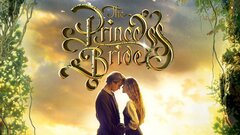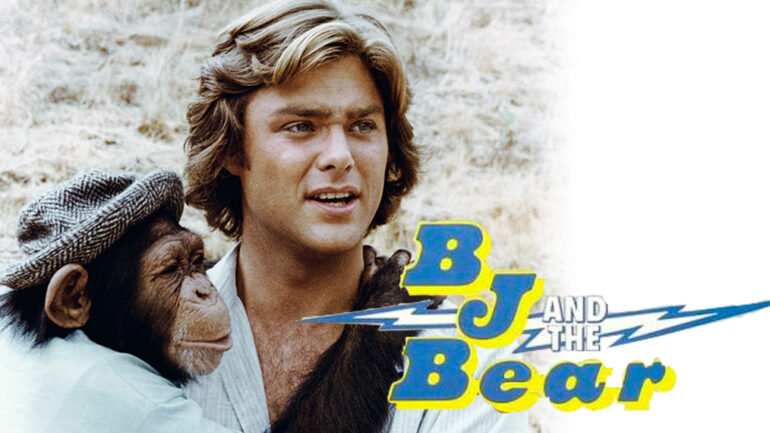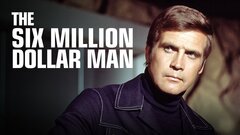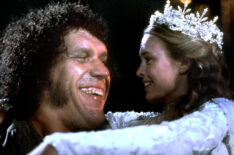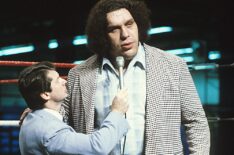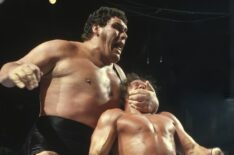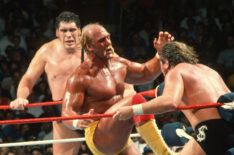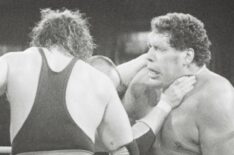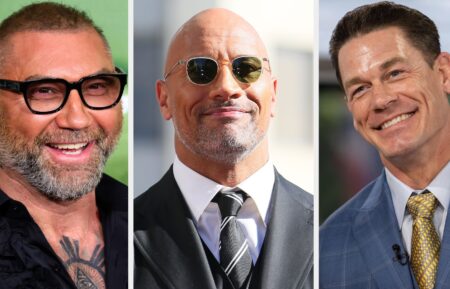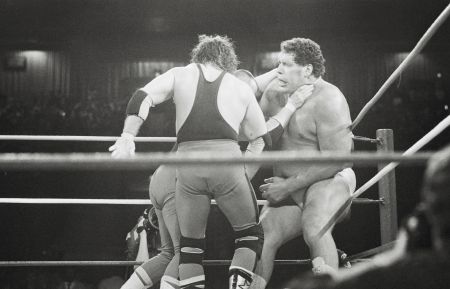A French-born pro wrestler-turned-pop cultural phenomenon, André the Giant suffered from acromegaly, which caused him to grow to seven feet tall and more than 500 pounds. Nicknamed "The Eighth Wonder of the World," the awe-inspiring André became a sports entertainment superstar when he joined the World Wrestling Federation (then known as the WWF). Buoyed by his massive size as well as his sweet nature, André became a fan favorite whose defeat by Hulk Hogan at "WrestleMania III" (1987) was considered by many to be the ultimate wrestling event of the era.
His innate likability translated to screen roles, and he appeared with several other pro wrestlers in Cyndi Lauper's music video for "The Goonies 'R' Good Enough" but he shone brightest as the kindly giant Fezzik in "The Princess Bride" (1987). He died of heart failure on Jan. 27, 1993 in Paris, France, but lived on as the inaugural inductee into the WWF Hall of Fame as well as the inspiration for Billy Crystal's "My Giant" (1998) and Shepard Fairey's "André the Giant Has a Posse"/"OBEY" iconic image. Retaining a place of affection in the hearts of a certain generation who grew up idolizing him, André the Giant left behind a legacy that was as much a testament to his enormous stature as well as his enormous charisma.
Born May 19, 1946 in Grenoble, Isère, France, André René Roussimoff had a hormonal disorder known as acromegaly, which caused his body to overdo its production of growth hormone. Although the rest of his family was of average stature, he was 6'3" by age 12 and would eventually reach 7 feet and more than 500 pounds. Accordingly, he would become famously known around the world as simply "André the Giant." After dropping out of school and leaving home at 14, he found a string of jobs that took advantage of his nearly superhuman strength, but discovered his true calling a few years later when a group of professional wrestlers took him under their wing and began to train him. Earning valuable ring experience throughout Europe, Asia, Africa and New Zealand, André worked steadily but found fame elusive until he moved to North America, where he notched considerable success wrestling in Montréal, Canada. This was only the beginning for André, however, for he ascended to true international superstardom when he was signed to the Word Wrestling Federation (known then as the WWF) in the early 1970s.
Repackaged as a supposedly 7'4" "Eighth Wonder of the World," André became a familiar face to American wrestling fans, but the WWF wisely limited his exposure and played up his size as the ultimate gimmick. Positioned perfectly, André was able to fully capitalize on the 1980s wrestling boom, and he became one of the decade's most beloved pro wrestlers, crossing paths with his fellow greats like Hulk Hogan and Ted "The Million Dollar Man" DiBiase and helping anchor such influential sports entertainment franchise smashes as "WrestleMania" (1985), "Wrestlemania 2" (1986), "Survivor Series" (1987) and "Royal Rumble" (1988). In line with his real-life good-hearted nature, André was initially cast as a hero, or "babyface," in the world of WWF, but achieved his greatest pop cultural moment when he turned villain, or "heel," during a high-profile feud with Hulk Hogan, which culminated in Hogan achieving the supposed impossible: bodyslamming André in "WrestleMania III" (1987). The increasingly dramatic and complicated tale of this feud delighted fans, as did additional spats like the one between André and Jake "The Snake" Roberts, which hinged on the former's supposed fear of the latter's pet boa constrictor, Damien. The wonderfully soapy story included such highlights as André suffering a heart attack in the ring due to proximity to Damien, but then getting revenge by not only pinning Roberts but also squashing a sack supposedly containing the reptile.
So popular was André that not only was he a featured character on the animated "Hulk Hogan's Rock 'n' Wrestling" (CBS, 1985-86) as well as in Cyndi Lauper's "The Goonies 'R' Good Enough" music video, but he also lensed a string of screen roles. Recurring as Bigfoot on "The Six Million Dollar Man" (ABC, 1974-78), André also landed small roles on "The Fall Guy" (ABC, 1981-86), "The Greatest American Hero" (ABC, 1981-83), "Conan the Destroyer" (1984) and "Micki + Maude" (1984). His most famous film role, however, came as the gentle giant Fezzik in "The Princess Bride" (1987). Showcasing his amazing physical stature as well as a true sweetness and light comedic touch, André's Fezzik proved one of the beloved film's most frequently quoted and fondly remembered highlights. Although he continued to wrestle for the WWF and also branched out to appear in World Championship Wrestling (WCW) and All Japan Pro Wrestling (AJPW) productions, his health worsened due in great part to his acromegaly. Wracked with pain and infirmities that belied his powerful stature, André died of heart failure on Jan. 27, 1993, while in Paris to attend his father's funeral. He left behind a vibrant legacy, however, becoming the first inductee into the WWF Hall of Fame as well as the inspiration behind his "Princess Bride" co-star Billy Crystal's film "My Giant" (1998). André also inspired the graphic artist Shepard Fairey to create a memorable piece entitled "André the Giant Has a Posse" which morphed into a close-up image of André's face and was eventually known as OBEY. Guaranteed to stand out due to his one-of-a-kind stature, André the Giant became a much loved hero for a certain generation and earned his own piece of pop cultural immortality despite his regrettably brief life.
By Jonathan Riggs
















